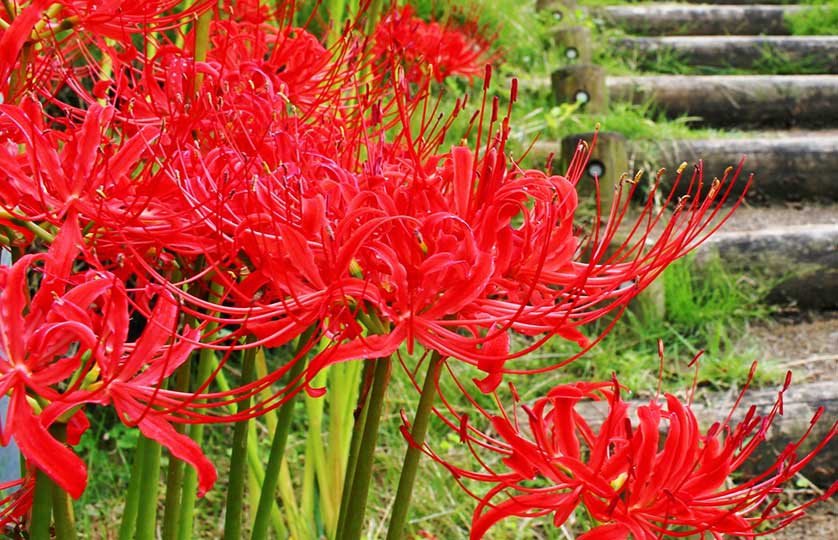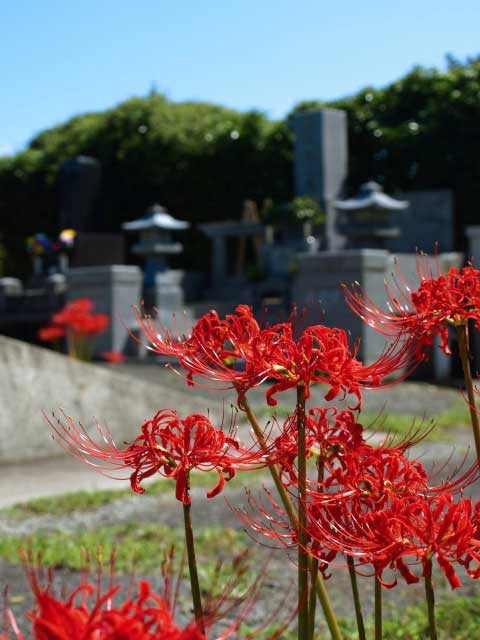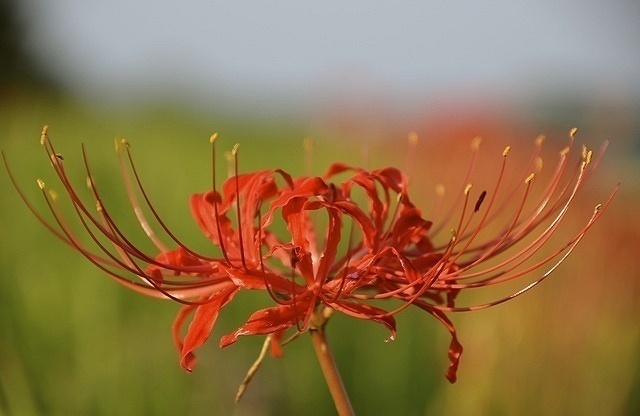
Let me first inform you that Higanbana is a flower that is significant to the people who live in Japan if you are looking for its meaning. It’s a mysterious flower with various meanings depending on hue and toxicity. I’ll address all the queries about the significance and urban legends around this flower today.
What Does Higanbana Mean, Then? Higanbana flower, also known as Red Spider Lily or Lycoris radiata, represents a melancholy recollection, a flower of death, a final farewell, and also refers to flowers from paradise. Higanbana (red spider lilies), according to Buddhists, are related to the samsara cycle of rebirth and death. Higanbana was used to guard rice fields in Japan since it kills anyone who eats it and is deadly to rats and other wild animals. Additionally, the red spider flower is buried in graves as a reminder of earlier times when pre-cremation was practiced to protect the deceased.
The manga “Higanbana no Saku Yoru ni” is well-known in Japan because it is based on actual incidents that took place in schools. The Unforgiving Flowers Blossom in the Dead of Night is another name for this manga in the English language. The name Higanbana is frequently sought as a result of this serial.
Now let’s talk about a few things and why it is named higanbana in Japan rather than spider lily.
Table of Contents
What Does Higanbana Symbolize?
The meanings of the higanbana flower include a flower of death, a final farewell, and a flower of the heavens. Higanbana (red spider lilies), according to Buddhists, are related to the samsara cycle of rebirth and death. Higanbana was used to guard rice fields in Japan since it kills anyone who eats it and is deadly to rats and other wild animals. Additionally, the red spider flower is buried in graves as a reminder of earlier times when pre-cremation was practiced to protect the deceased.
According to legend, flowers only bloom in locations where people split ways. Although Japanese has various identifiers, the most are frightening names like “flowers of doom.” The explanation behind this flower’s ominous name is complicated. That’s where this flower is blooming at the moment.
The various hues of the spider lily (higanbana) blossom are seen here:
Many myths and stories coexist among the people of Japan. These myths are typically associated with the mysticism of the nation and are not restricted to any particular animals, living things, or even symbolic places. They might impact Japan’s flora as well. The following tells the tale of a special flower that blooms next to graves and symbolizes death. By revealing its petals and igniting into passionate flames, this red flower served as inspiration for numerous artists to create Haiku or even Ukiyo-e.
The red spider lily is also known as higanbana, red spider lily, or Lycoris Radiata. The name kajibana, which means “fire flower,” is another popular one. Its pink petals, which resemble flames when they bloom, compel many people to equate it with fire; therefore, the name “kajibana.”
It’s possible that this flower’s numerous sinister names are a result of its blood-red hue and frequent occurrences in cemeteries.
One explanation is that the red spider lily bloom period takes place around the time of the autumnal equinox, which marks the start of the fall season. The precise date is every year’s first day of the autumn season, which is September 22.
The spider lily plant, commonly known as the red magic lily and Equinox flower, has the scientific name Lycorisradiata. They gave this name to the blooms because of how they resemble spiders. They were first cultivated in the United States, where people adored the various flower hues, after being discovered in Asian nations including China, Nepal, and Korea. As it grew next to a river, it is frequently connected to river banks, hills, cemeteries, and rice fields in Japan.
It is a perennial herb that can grow again each year. It has long stamens, petals, and natural curves that give it the impression of a funnel. It has no leaves on its very long, leafless stem. These plants are hardy in zones 7 to 10 and bloom in the early fall.
What is Higanbana?

- / Shinto Shrine / Buddhist Temple
- Grave (Cemetery) (Cemetery)
- Rice Field / Farm Road
- Canal Bank
- (Hill/Mountain) Slope
The sites where these flowers bloom are linked by something. Additionally, it had a function and was placed on purpose.
After a long, scorching summer, the start of autumn is signaled by the appearance of the spider lilies in mid-September. If you happen to be in Japan during that season, it’s worth making the extra effort to see some Higanbana Spider Lilies. Tall stalks with gorgeous 2 or 3 weeks long.
In Japan, this blossom is frequently seen to be a bad omen. In the context of a crimson or heavenly flower, it might also be a favorable sign. Its very deadly bulb is frequently used to adorn graves and deter rodents off of lawns.
Why is Higanbana called the Japanese flower of death?
Bulbs of the hoganabana (Lycoris Radiata) are extremely poisonous. These are most frequently employed in Japan, where they are intended to keep mice and vermin out of homes and rice paddies. Therefore, the majority of them now grow close to waterways. In Japan, the crimson spider lily signals the start of autumn. A ritual at the graves of the ancestors will be held on this day to celebrate the beginning of fall among many Buddhists.
As a homage to the deceased, they are grown on cemeteries. People hold the view that red spider lilies shouldn’t ever be given as a bouquet since they are connected to death. It is referred to as the “flower of death” for this reason.
There could be a few problems if you’re inquiring why your spider plant isn’t blooming or making, well, baby spiders:
- He might simply be too young, after all. It might take a few years, but I’m not sure how old the plant needs to be.
- Some contend that it must have seemed crowded for people to start removing the runners that bloom and generate baby spiders. When I say crowded, I really mean root bound. Although I haven’t verified it, this presumption seems reasonable.
- bad lighting These are understory-dwelling plants that favor filtered light. Do not expose it to the sun, please.
- Perhaps all that’s needed is some food. Use a balanced liquid fertilizer, if possible. Just enough; heed the directions.
- They favor dampness that is constant. If the leaves don’t get enough water, they become dry. In excess, they can cause “root rot,” which, ironically, hinders the plant’s ability to obtain water.
What does equinox flower mean?
Higanbana, which translates to “Flower of the Equinox,” is a Buddhist holiday during which graves are washed. Other names for this flower, however, include “the flower with 600 names,” “the flower of the spectres (yuureibana),” “the flower of hell (jigokubana),” “fox flower (kitsunebana),” and many more. It originated in China, Korea, and Nepal before being imported to Japan later on. The hypothesis that it was first used in rice farming is the one that is generally accepted. Late summer and early fall are often the times when flowers bloom.
In a symbolic sense, the significance of the Higanbana flower represents a final separation. As a result, giving anything to someone you like is inappropriate. This emblem is derived from the tale of two Chinese elves named Manju and Saka. The flower should be taken care of by one, and the leaves by the other. They attended the meeting despite being prohibited from doing so. A strong mutual love developed at that point, which enraged the goddess Amaterasu.
Equinox flower myth
Manjusaka is reportedly another name for the Equinox Flower, often known as the crimson Spider Lily. It is based on an old Chinese myth about two elves, Saka and Manju, who were the protectors of leaves and flowers, respectively. Since the plant never blooms its flowers and leaves at the same time, they could never meet. They disobeyed gods to set up a meeting because they were both interested and eager to get to know one another. They were immediately chastised by the gods, who also parted them for good. The flower continues to be linked to memory loss, loss of loved ones, and loss of loss.
These flowers are adored by many due of their links with both light and darkness and the sense of nostalgia they evoke. After the first autumnal rain, you finally caught sight of them. The sun was shining brightly, and the sky was blue. The dense, light green and straw-colored grasses along the riverside close to my house were lighted by these higanbana fireballs. They appeared to be a group of soldiers bursting forth from the depths. It looked wirey, noble, lush, and menacing. Mother Nature ignites the aging ground by striking summer with a fiery sickle. The dreamily swaying straw is traversed by the Red Spiders.
The fact that the leaves and blossoms never touch is another characteristic of flower petals. A lengthy shaft that emerges directly from the earth bears the blossoms. After the blossoms have faded and the post has rotted, the leaves emerge. Due to the fact that there is always one component lacking, the plant cannot ever be regarded as a “full set”. As a result, the flower has come to represent separation and lost love in China and Korea.
Although the higanbana may make some individuals feel depressed, their primary appeal is their beauty. Don’t miss the season; leave the city and take advantage of it.

